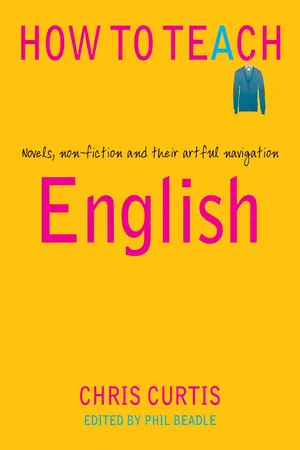
- 256 pages
- English
- ePUB (mobile friendly)
- Available on iOS & Android
About This Book
Written by Chris Curtis, How to Teach: English: Novels, non-fiction and their artful navigation is jam-packed with enlivening ideas to help teachers make the subject of English more intellectually challenging for students - and to make it fun too!
Never underestimate your duty and power as a teacher of English. English teachers help students to think and feel. They prompt them to reflect on their actions. They hold a mirror to society and inspire students to see how they can make it better.
What other subject does that?
This insightful interpretation of what makes excellent secondary school English teaching is the work of a man whose humility fails to hide his brilliance and provides educators with a sophisticated yet simple framework upon which to hook their lessons. Covering poetry, grammar, Shakespeare and how to teach writing, Chris Curtis has furnished every page of this book with exciting ideas that can be put into practice immediately.
Each chapter presents a store of practical strategies to help students in key areas - providing apposite examples, teaching sequences and the rationale behind them - and has been accessibly laid out so that teachers can pinpoint the solutions they need without having to spend an age wading through academic theory and pontification.
The book explores the wealth of learning opportunities that can be derived from both classic and more contemporary literature and offers expert guidance on how teachers can exploit their own chosen texts to best effect with their students. Furthermore, it is replete with ready-to-use approaches that will help teachers upgrade their lesson planning, enhance their classroom practice and ensure that the content they cover sticks in their students' heads for months and years afterwards.
Suitable for all English teachers of students aged 11-18.
Frequently asked questions
Information
HOW TO TEACH POETRY
Table of contents
- Cover
- Praise
- Title Page
- Acknowledgements
- Foreword by Phil Beadle
- Contents
- Introduction
- 1: How to Teach Poetry
- 2: How to Teach Writing – Part 1
- 3: How to Teach Novels
- 4: How to Teach Essay Writing
- 5: How to Teach Non-Fiction
- 6: How to Teach Shakespeare
- 7: How to Teach Students to Analyse Texts Effectively
- 8: How to Teach Accuracy
- 9: How to Teach Grammar
- 10: How to Teach Writing – Part 2
- Conclusion
- Afterword
- References and Further Reading
- Recommended Websites
- Index
- Copyright